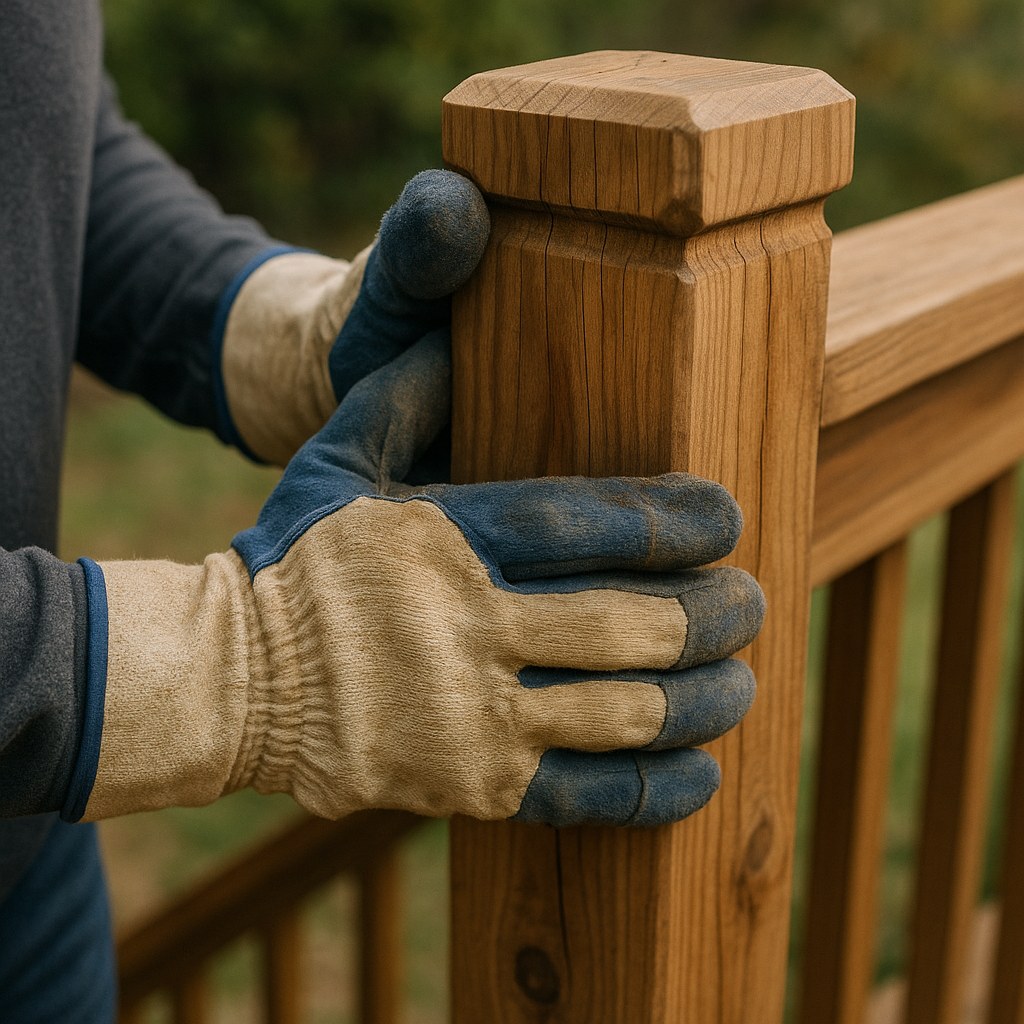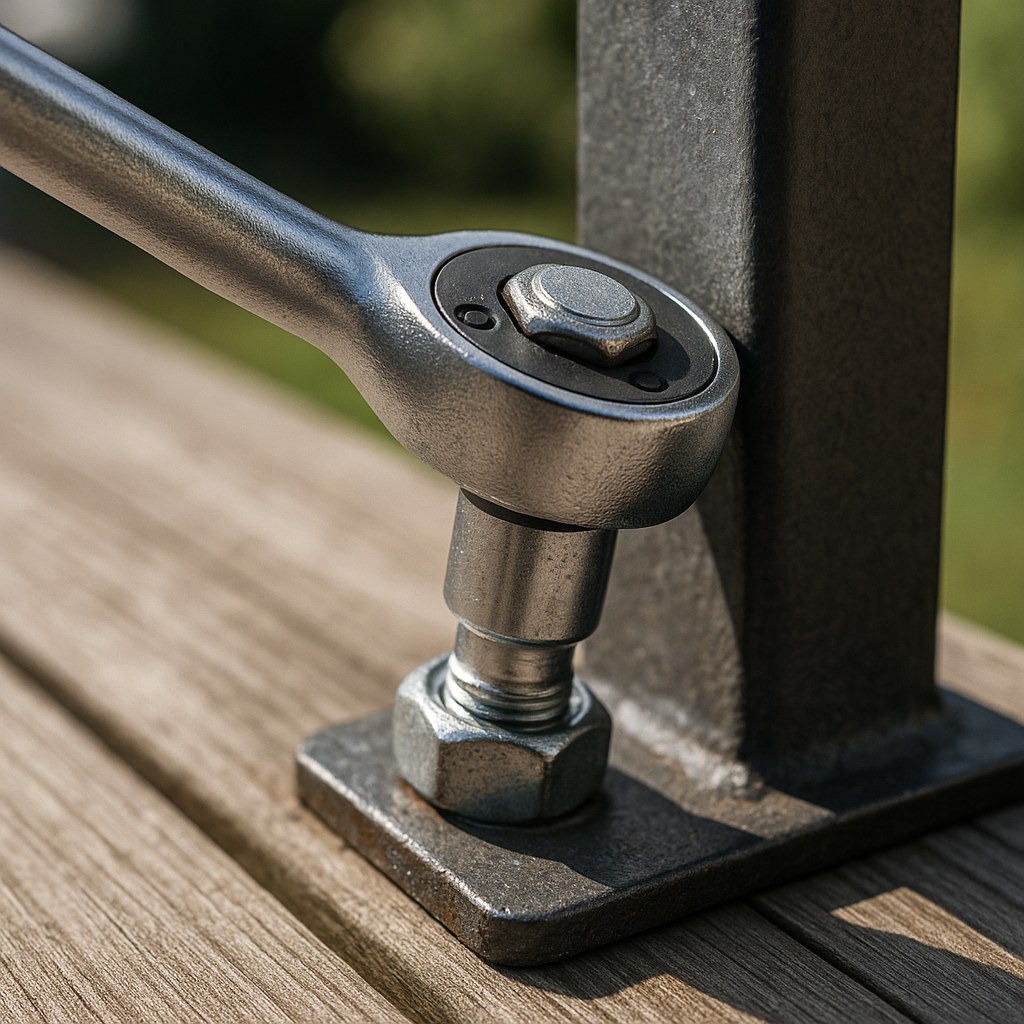How to Fix a Loose Deck Railing A Step by Step Guide
That subtle creak or noticeable wobble in your deck railing is more than just a minor annoyance—it's a critical safety warning. A secure railing is the only thing standing between a relaxing afternoon on the deck and a dangerous fall. The good news is that you don't have to live with that feeling of uncertainty. Most loose deck railings can be fixed with a bit of DIY know-how and a few common tools.
Think of me as your expert on the line, ready to walk you through this fix. We’ll figure out exactly what’s causing the problem and get it sorted out, step by step. Whether your railing is made of classic wood, modern metal, or sleek cable, this guide will help you restore its strength and make your deck a safe haven for your family and friends once again.
Why You Can't Afford to Ignore a Loose Railing
Before we grab our tools, let's talk about why this is such an important job. According to the International Association of Certified Home Inspectors, a staggering 60% of decks in the U.S. are not completely safe, with railing failure being a primary cause of injury. A wobbly railing can indicate several underlying issues:
- Immediate Safety Hazard: This is the most obvious reason. Railings are designed to withstand significant force, but a compromised one can fail unexpectedly, leading to serious injuries.
- Indicator of Deeper Problems: A loose post could be a symptom of wood rot, insect damage, or corroded fasteners within your deck's structure. Ignoring it allows these problems to worsen, leading to far more expensive repairs down the line.
- Loss of Home Value: A well-maintained deck is a huge asset. A shaky, unsafe railing not only looks bad but can be a major red flag for potential homebuyers.
Fixing it now saves you money, prevents potential accidents, and gives you invaluable peace of mind.

Step 1: Your Initial Safety Check
First things first: we need to understand the scope of the problem safely.
- Clear the Area: Ask everyone to stay off the deck, especially near the wobbly section. This is particularly important for children and pets.
- Gear Up: Put on a pair of sturdy work gloves to protect your hands from splinters or sharp edges.
- Perform the Shake Test: Start at one end of your deck and work your way to the other. Gently but firmly shake each railing post. Is the looseness isolated to just one post or a single section between two posts? Or do multiple posts feel unstable?
If you find that several sections or the entire railing system moves, stop right there. This indicates a potentially widespread structural problem. Your best and safest move is to call a licensed deck contractor to perform a thorough inspection.
If the wobble is contained to a single section, great! That's a problem we can likely solve together. Let's move on to diagnosis.
Step 2: Pinpoint the Cause of the Wobble
With your loose section identified, take a closer look to determine the cause. The fix will depend entirely on your railing's material and what has failed.
- For Wood Railings: Look for signs of rot at the base of the post, which will appear dark, soft, or spongy. Check if screws or bolts have backed out, rusted through, or are missing entirely.
- For Metal Railings: Inspect for rust and corrosion, especially where the post meets the deck and at any connection points. Check for loose or stripped bolts.
- For Cable Railings: Pluck the cables. Are they slack? Check the posts themselves—are they wobbly, or is it just the cables?
- For Glass Railings: Examine the brackets holding the glass panel. Are the set screws loose? Are the rubber gaskets inside the brackets still in place?
Once you know your material and have a good idea of the issue, you can jump to the right fix.
How to Fix a Loose Wood Deck Railing
Wood railings are common, and so are their issues. Here’s how to tackle the most frequent problems.
If You Find Rotting Wood
Rotten wood can't be tightened; it must be replaced.
- Mark and Cut: Identify the rotten section of the post or rail and use a pencil to mark a few inches beyond the damaged area on both sides. Use a reciprocating saw to carefully cut out and remove the rotten piece.
- Measure and Replace: Measure the gap precisely with a tape measure. Cut a new piece of pressure-treated wood to the exact same length.
- Seal the Deal: Brush a wood preservative on all freshly cut ends of both the new piece and the existing railing. This prevents future moisture damage.
- Install the New Piece: Fit the new wood piece into the gap. Drill pilot holes and secure it to the adjoining wood using galvanized wood screws designed for exterior use.
- Protect Your Hardware: Cover the screw heads with an exterior-grade wood filler to lock out moisture. Let everything set for 24 hours before testing.
If the Hardware is Loose or Missing
This is often the simplest fix!
- Tighten Everything: Using a drill or socket wrench, tighten every screw and bolt connecting the post and rails.
- Fix Stripped Screw Holes: If a screw just spins in its hole without tightening, the wood fibers are stripped. To fix this, remove the screw. Squeeze some wood glue onto a wooden dowel (or a few toothpicks) and insert it into the hole. Break it off flush with the surface. After the glue sets for a few minutes, you can drill a new pilot hole and drive in a new, slightly larger galvanized screw for a super-tight grip.
If Tightening Isn't Enough: Reinforce with Blocking
If the hardware is tight but the post still wobbles, it’s not properly secured to the deck’s frame (the joists). Adding blocking will solve this.
- Measure and Cut: Measure the space between the wobbly railing post and the nearest deck joist. Cut a piece of pressure-treated 2x6 or 2x8 lumber to fit snugly in this gap.
- Install the Block: Position the wood block firmly between the post and the joist.
- Secure It: Drill pilot holes and drive at least two galvanized wood screws or lag bolts through the block into the post, and two more through the block into the joist. This creates an incredibly strong, rigid connection that eliminates wobbling.

How to Fix a Loose Metal, Cable, or Glass Railing
Modern railing systems have their own unique connection points that can loosen over time.
For Metal Railings
The culprit is usually loose hardware or corrosion.
- Tighten the Hardware: Use a ratchet wrench to tighten all the nuts on the bolts that hold the posts and brackets together. If a bolt is stripped or heavily rusted, replace it with a new stainless-steel one.
- Secure the Post Base: If the post is wobbly at the bottom, the connection to the deck is the problem. Unscrew the bolts at the post’s base plate. Apply a generous layer of exterior-grade construction adhesive to the bottom of the plate, then set it back in place. Drive new, heavy-duty stainless-steel screws through the plate into the solid deck framing or blocking below.
For Cable Railings
Loose cable railings are typically due to slack in the cables or wobbly posts.
- Adjust Cable Tension: Each cable run has a tensioning mechanism, usually a turnbuckle. Use a wrench to turn the turnbuckle clockwise, which will tighten the cable. The cable should be taut but still have a tiny bit of give.
- Tighten the Posts: If the posts themselves are moving, use a ratchet wrench to tighten the lag screws or through-bolts that anchor them to the deck frame.
For Glass Panel Railings
Safety first: place a thick towel on the deck below the glass panel to protect it. The issue is almost always the brackets. Use a hex key (Allen wrench) to tighten the small set screws on each bracket that clamp onto the glass. Make sure the rubber gaskets are in place to cushion the glass and provide a snug fit.
Cost to Fix a Loose Deck Railing: DIY vs. Hiring a Pro
Fixing a loose railing yourself can be incredibly cost-effective.
- DIY Cost: For most simple fixes, you'll only need a handful of new fasteners. You can expect to spend $20 to $50 on galvanized screws, stainless-steel bolts, or a tube of construction adhesive. Even replacing a small section of wood is affordable.
- Professional Cost: If you're not comfortable with the work or if the problem is more complex, hiring a handyman or contractor is a great option. According to HomeAdvisor, a simple railing repair can cost anywhere from $150 to $500, depending on the material and the extent of the labor required. For widespread issues, the cost can be higher.

Your Deck is Safe Again
There’s nothing better than the confidence of knowing your deck is secure for everyone who uses it. By taking an hour or two to diagnose and fix that wobbly railing, you’ve not only performed a crucial safety upgrade but also protected your home's value and prevented a small problem from becoming a big, expensive one.
If you ever run into a home maintenance issue that feels too big to handle, or if you just want access to more expert guides like this one, download the Casa app. We provide the tools, knowledge, and connections to trusted professionals to help you manage your home with confidence.

